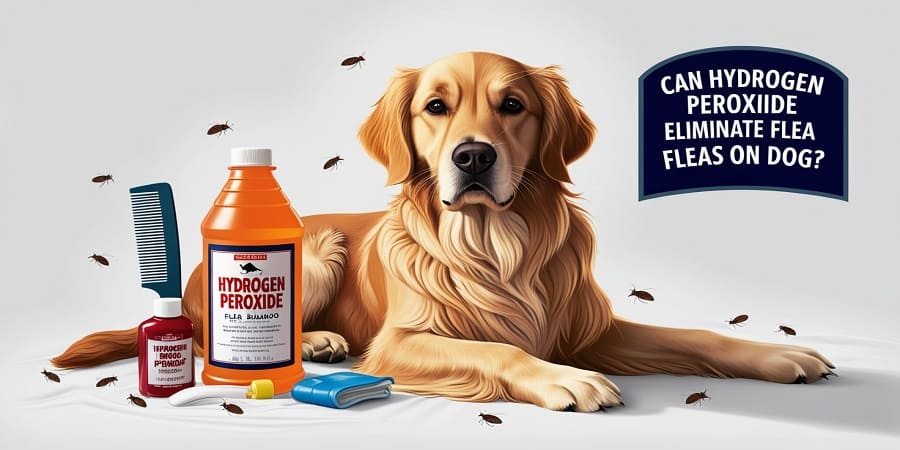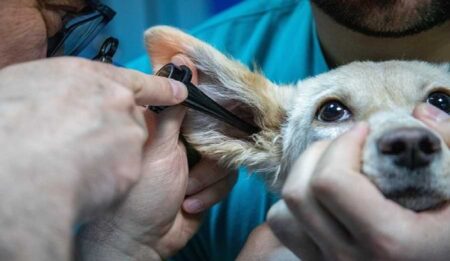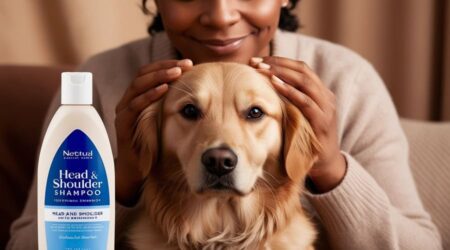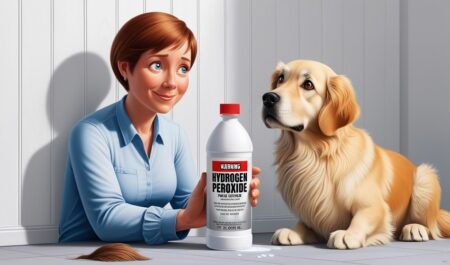Is hydrogen peroxide really so effective in getting rid of fleas? It is well known for its many purposes in both medicine and household cleaning. This query comes up frequently from Dog owners looking for different ways to keep fleas under control. Although hydrogen peroxide has antibacterial and antiseptic qualities, there is significant disagreement regarding how effective it is against fleas. Making wise decisions about the usage of hydrogen peroxide requires knowledge of its possible drawbacks as well as how it interacts with fleas. There are particular techniques needed to get rid of fleas, a bug that is known for infesting houses and pets. This introduction investigates the possibilities of hydrogen peroxide as a flea-eliminating chemical, going into its workings and its uses. Pet owners can decide if hydrogen peroxide is a good alternative for treating fleas by looking at the scientific data and practical factors.
- The Mechanism behind Hydrogen Peroxide’s Flea Elimination
- Cleaning Pets: Essential Ingredients
- Application Instructions for Pet Cleaning
- Considerations: Advantages and Disadvantages
- Disadvantages:
- Cleaning Fabric with Hydrogen Peroxide: Necessary Components
- Instructions for Fabric Cleaning
- Is Washing Your Dog with Hydrogen Peroxide Effective for Flea Control?
- When bathing a flea-infested dog, do the fleas drown?
- Utilizing Hydrogen Peroxide to Combat Fleas on Pets: Step-by-Step Instructions
- Is Hydrogen Peroxide Usage Safe for Flea Control?
- Is it Safe to Cleanse My Dog with Hydrogen Peroxide?
- Determining the Appropriate Use of Hydrogen Peroxide for Canine Care
- Can You Put Peroxide in a Dog’s Ear?
- Does hydrogen peroxide effectively eliminate fleas on pets?
- Conclusion:
- Frequently Asked Questions
The Mechanism behind Hydrogen Peroxide’s Flea Elimination
Hydrogen peroxide’s oxidative qualities are the main mechanism by which fleas are eliminated. When applied, hydrogen peroxide disintegrates into water and oxygen, generating protons that can harm fleas’ exoskeletons and respiratory systems. This oxidative stress impairs essential cellular processes, which ultimately results in fleas dying. Furthermore, the foaming action of hydrogen peroxide helps to suffocate and loosen fleas from the host’s fur, making it easier to remove them while grooming. Hydrogen peroxide can be useful against adult fleas upon contact, but its effectiveness against flea eggs and larvae varies, thus repeated and thorough treatments are necessary for efficient flea management.
Cleaning Pets: Essential Ingredients
The proper components are needed to clean dogs safely and effectively. The following are necessary elements for cleaning pets:
Mild pet shampoo: Designed especially to prevent skin irritation in pets.
Warm water: Perfect for a relaxing soak in the tub.
Hydrogen peroxide solution (optional): May aid in disinfecting wounds and getting rid of fleas.
Soft-bristled brush: aids in cleaning out loose fur and grime.
Towels: To gently dry your pet after wash time.
Treats: Rewards help enhance your pet’s enjoyment of the washing process.
Application Instructions for Pet Cleaning
In order to clean your pet properly, adhere to these application guidelines:
- Prepare a warm bath with mild pet shampoo and water.
- Wet your pet’s fur thoroughly, avoiding the eyes and ears.
- Apply the shampoo, lathering gently from head to tail.
- Rinse thoroughly to remove all soap residue.
- Optionally, apply a diluted hydrogen peroxide solution to targeted areas for flea control.
- Dry your pet with towels, ensuring they are warm and gentle.
- Brush your pet’s fur to remove tangles and excess fur.
- Reward your pet with treats for cooperation during the cleaning process.
Considerations: Advantages and Disadvantages
Flea control By killing fleas on touch, hydrogen peroxide helps lessen infestations.
Antiseptic properties:
Because of its antibacterial qualities, it helps to disinfect wounds.
Economical: Comparatively speaking, hydrogen peroxide is less expensive than specialty pet cleaning supplies.
Disadvantages:
Potential skin irritation: Dilution is necessary because concentrated hydrogen peroxide can irritate delicate skin.
Limited efficacy against eggs and larvae: Even while it works well against adult fleas, flea eggs and larvae may not completely disappear..
Bleaching effect: Fabric or fur can be bleached with hydrogen peroxide at higher quantities.
Toxicity risk: Pets may become ill if they consume huge amounts, therefore use caution while applying.
Cleaning Fabric with Hydrogen Peroxide: Necessary Components
The hydrogen peroxide solution itself, which should be diluted with water and have a concentration of 3% to 6%, is a necessary ingredient for cleaning cloth with hydrogen peroxide. A spray bottle or applicator is also required for uniformly dispersing the solution onto the fabric. To gently scrub and blot the stained areas, use a clean sponge or cloth. Alternatively, you might want to keep baking soda on hand to mix with hydrogen peroxide for better stain removal on more stubborn stains, like blood or wine. Together, these elements efficiently combat a variety of stains and revitalize fabric surfaces.
Instructions for Fabric Cleaning
The following guidelines can help you use hydrogen peroxide to clean textiles effectively:
- If necessary, dilute hydrogen peroxide with water in accordance with suggested ratios.
- Verify the colorfastness of the fabric in a tiny, discrete region.
- Using a spray bottle or applicator, apply the hydrogen peroxide solution directly to the affected area.
- Using a fresh cloth or sponge, blot the stain moving toward the center from the outside..
- If needed, carry out the procedure again to get rid of the discoloration.
If necessary, wash the fabric as normal.
Is Washing Your Dog with Hydrogen Peroxide Effective for Flea Control?
To a certain extent, using hydrogen peroxide to wash your dog can help control fleas. The foaming effect of hydrogen peroxide may aid in suffocating and removing adult fleas from the fur of your dog. Furthermore, the antibacterial qualities of it can help decontaminate and sanitize flea-infested regions. Hydrogen peroxide, however, might not be able to totally get rid of flea infestations, particularly if the eggs and larvae are still present. It’s important to correctly dilute hydrogen peroxide because concentrated forms of the solution can irritate your dog’s skin. Although it can be included in a flea control regimen, for complete pest management, it is best to combine it with other flea treatments and preventive measures.
When bathing a flea-infested dog, do the fleas drown?
Most of the time, fleas that are bathed in water do not drown. Because they can breathe through air bubbles, fleas are hardy pests that can withstand prolonged submersion in water. Bathing may temporarily paralyze the fleas, forcing them to float to the surface of the water rather than drown. Fleas, on the other hand, can swiftly relocate to higher surfaces on the dog’s body to escape drowning. Using a flea shampoo or other flea control solutions made especially to target and kill these parasites during washing is crucial to successfully getting rid of fleas. appropriate methods for taking a bath.
Utilizing Hydrogen Peroxide to Combat Fleas on Pets: Step-by-Step Instructions
For hydrogen peroxide treatment to be effective against fleas on pets, carefully follow these steps:
Dilute: To make a safe solution, combine hydrogen peroxide with water, usually in a 1:1 ratio.
Bathe: Apply the diluted solution all over your pet’s fur, being careful not to get any in their eyes or ears.
Lather: Create a thick foam with pet shampoo and use it to wash the fur and skin.
Rinse: Rinse your pet’s fur with fresh water to get rid of all hydrogen peroxide and shampoo residue..
Dry: To thoroughly dry your pet’s fur, use a soft towel or a low-temperature, cool-setting blow dryer.
Is Hydrogen Peroxide Usage Safe for Flea Control?
When using hydrogen peroxide to treat fleas, safety must always come first. Hydrogen peroxide can be useful in the fight against fleas, but use caution when using it. Pets can safely use hydrogen peroxide as long as it is diluted properly. However, pets may experience skin irritation or other negative responses as a result of concentrated solutions or incorrect application. It’s critical to adhere to the application instructions and suggested dilution ratios given by veterinarians or other pet care experts. Furthermore, hydrogen peroxide should not come in contact with your pet’s eyes, ears, or other delicate parts. To ensure safe and efficient use, speak with a veterinarian before using hydrogen peroxide for flea management.
Is it Safe to Cleanse My Dog with Hydrogen Peroxide?
When done properly, cleaning your dog with hydrogen peroxide can be safe, but you must exercise caution. Before using hydrogen peroxide on your dog, make sure the solution is appropriately diluted to prevent skin irritation and other negative effects. It can also cause irritation or harm, therefore it should not come into contact with your dog’s eyes, ears, or mucous membranes. Before using hydrogen peroxide for dog cleaning, it is best to speak with a veterinarian to make sure it is suitable for your pet’s particular needs and to get advice on the right dilution ratios and application methods for a safe and efficient use.
Determining the Appropriate Use of Hydrogen Peroxide for Canine Care
Determining the appropriate use of hydrogen peroxide for the care of dogs requires careful consideration of a number of criteria. It is essential to speak with a veterinarian to establish the best way to use it for your dog’s particular needs and health. Among other things, hydrogen peroxide can be used to treat wounds, clean ears, and get rid of fleas. To guarantee safety and effectiveness, nevertheless, its concentration, dilution, and application techniques need to be properly adjusted. Veterinarian advice helps you avoid potential problems like skin irritation or ingesting it, and it guarantees that hydrogen peroxide is added to your dog’s care routine in a responsible and efficient way that will benefit their general health.
Can You Put Peroxide in a Dog’s Ear?
It is possible to apply hydrogen peroxide to a dog’s ear, but you must proceed with caution and get veterinary advice before doing so. with order to aid with dog ear cleaning, hydrogen peroxide can help loosen and remove extra wax or debris from the ear canal. But before using it, make sure to thoroughly dilute it with water to prevent irritation or harm to the sensitive ear tissues. In addition, ear canal discomfort or inflammation may result from overusing or using hydrogen peroxide incorrectly. To verify that hydrogen peroxide is used safely and efficiently for your dog’s ear care needs, speak with a veterinarian.
Does hydrogen peroxide effectively eliminate fleas on pets?
Hydrogen peroxide can be effective in eliminating fleas on pets to some extent. Its oxidizing properties can help kill adult fleas on contact, and its foaming action may aid in suffocating and dislodging fleas from the pet’s fur. However, hydrogen peroxide may not fully eradicate flea infestations, especially if flea eggs and larvae are present in the environment. Additionally, concentrated hydrogen peroxide can irritate a pet’s skin, so it’s crucial to dilute it properly and use it with caution. While it can be part of a flea control regimen, combining it with other flea treatments and preventive measures is advisable for comprehensive flea management.
Hydrogen peroxide can be effective in eliminating fleas on pets to some extent. Its oxidizing properties can help kill adult fleas on contact, and its foaming action may aid in suffocating and dislodging fleas from the pet’s fur. However, hydrogen peroxide may not fully eradicate flea infestations, especially if flea eggs and larvae are present in the environment. Additionally, concentrated hydrogen peroxide can irritate a pet’s skin, so it’s crucial to dilute it properly and use it with caution. While it can be part of a flea control regimen, combining it with other flea treatments and preventive measures is advisable for comprehensive flea management.
Conclusion:
hydrogen peroxide can be an effective instrument in the fight against fleas on dogs, but its application calls for caution and adherence to the right protocols. Although hydrogen peroxide has the ability to kill fleas and can be useful when applied correctly, it must be diluted adequately to prevent skin irritation or other negative effects on pets. To ascertain the proper dilution ratios, application techniques, and frequency of administration based on your pet’s particular needs and health status, speaking with a veterinarian is strongly advised. Pet owners can contribute to a safe and efficient method of flea removal while preserving the health of their pet by adhering to veterinarian advice and use hydrogen peroxide as part of an all-encompassing flea management plan.
Frequently Asked Questions
Is it safe to spray hydrogen peroxide directly on my dog’s fur for flea control?
Hydrogen peroxide can be used to kill fleas, but it must be diluted properly and kept away from delicate places like the mouth, ears, and eyes. It is best to speak with a veterinarian before applying.
How does hydrogen peroxide work to kill fleas on dogs?
As an oxidizing substance, hydrogen peroxide can destroy adult fleas by upsetting their respiratory and cellular structures.
What concentration of hydrogen peroxide should be used for spraying on dogs?
3% solution, which is frequently seen in stores, is usually a safe concentration to use on dogs. But prior to application, it must be further diluted with water.
Are there any potential side effects or risks associated with using hydrogen peroxide on dogs for flea treatment?
It is important to dilute concentrated hydrogen peroxide adequately because it can irritate a dog’s skin. It can also not be appropriate for dogs with open wounds or sensitive skin.
Can hydrogen peroxide effectively eliminate flea eggs and larvae on my dog?
When it comes to adult fleas, hydrogen peroxide works better than eggs or larvae. While it might aid in decreasing their population, complete environmental treatment is also required to deal with fleas at all stages of life.
How often should I spray hydrogen peroxide on my dog to control fleas?
The degree of the flea infestation and the particular product being used determine how often it should be used. Choosing a suitable treatment plan might be made easier by speaking with a veterinarian.
Are there any precautions I should take when using hydrogen peroxide for flea control on my dog?
Indeed, keep hydrogen peroxide away from the dog’s face and give them a thorough rinse to avoid gastrointestinal issues or skin irritation. It’s also critical to keep an eye out for any negative reactions in your dog following application.
Can hydrogen peroxide be used in combination with other flea treatments for enhanced effectiveness?
Yes, hydrogen peroxide can be used with other flea treatments; however, to ensure safety and compatibility, carefully follow the product directions and speak with a veterinarian.
Will spraying hydrogen peroxide on my dog’s fur affect its skin or coat?
Although applying diluted hydrogen peroxide to a dog’s fur is generally safe, it’s important to keep an eye out for any indications of skin irritation or allergic responses. Dryness can be avoided by using a hydrating shampoo or conditioner after treatment.
Are there any alternative methods or products for flea control on dogs besides hydrogen peroxide?
Indeed, there are a number of substitute flea control products and techniques available, including as oral pills, flea collars, topical spot-on treatments, and natural cures. Getting advice from a veterinarian can help you decide which course of action is best for your dog.









